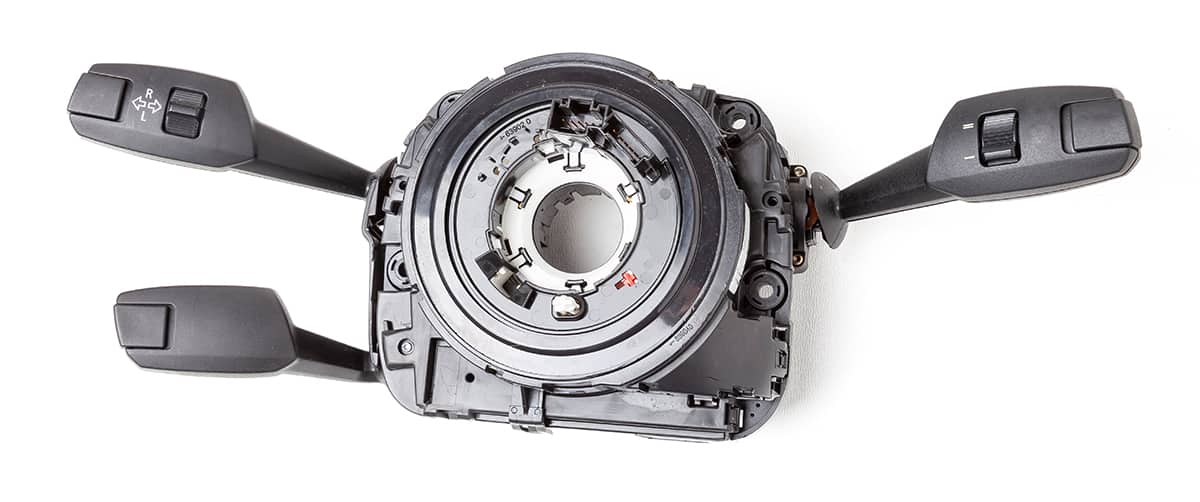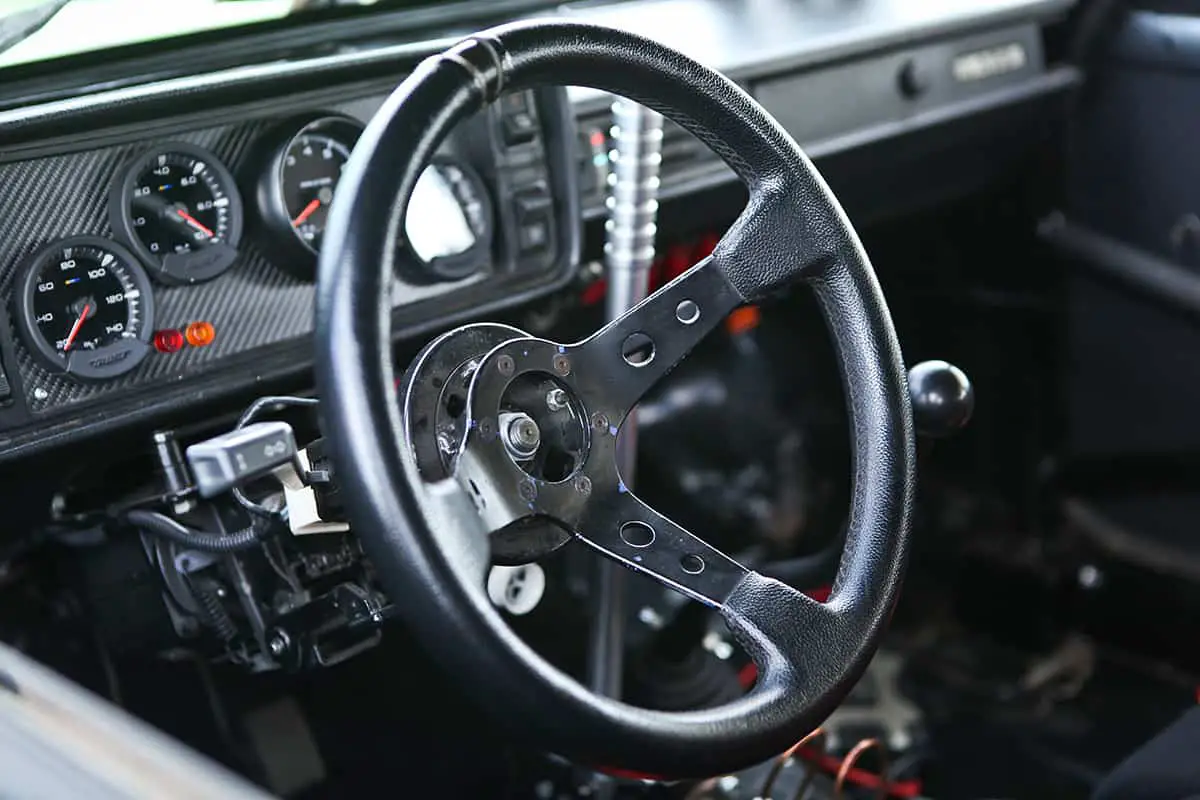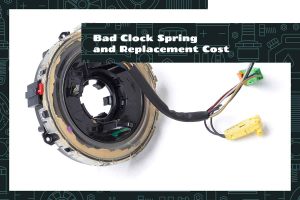Steering angle sensors work behind the scenes, monitoring and reporting the direction in which the steering wheel is turned. Its primary purpose is to ensure the stability of your vehicle, particularly when driving around corners, or during more intricate maneuvers.
When functioning optimally, it promotes smooth driving experiences and prevents accidents. But when it doesn’t, you’ll definitely notice something is off.
Key symptoms of a bad steering angle sensor are as follows:
- Unpredictable steering behavior
- Activation of the stability control warning light
- Erratic functioning of the traction control system
- Issues with the anti-lock braking system
- Unusual tire wear
In this guide, we will take a look at the importance of steering angle sensors, signs of a faulty sensor, potential risks, and ways to fix these problems.
Role and Function of the Steering Angle Sensor

The steering angle sensor (SAS) is a tiny but crucial component housed within your car’s steering column. It’s designed to measure the direction and rate at which the steering wheel turns. This sensor is directly linked with your vehicle’s electronic stability control system, often communicating with other sensors like the wheel speed and yaw rate sensors. It provides real-time steering wheel angle data to the electronic control unit (ECU), ensuring that your vehicle reacts correctly to your steering input.
The primary role of the steering angle sensor is to monitor the angle at which you turn the steering wheel and how quickly you do it. It communicates this data to the ECU. In turn, the ECU uses this information along with data from other sensors to control systems like Electronic Stability Control, Anti-lock Braking System (ABS), and traction control.
Electronic Stability Control (ESC) uses steering angle sensor data to help maintain your vehicle’s stability, especially during abrupt maneuvers. For instance, if your vehicle starts to understeer or oversteer (where the car veers less or more than intended), the ESC system uses steering angle data to correct the vehicle’s path, ensuring safer handling.
Similarly, the Anti-lock Braking System uses data from the steering angle sensor to prevent the wheels from locking up during sudden braking, ensuring you maintain steering control. If the sensor detects a difference between your steering input (where you want to go) and the vehicle’s direction, the ABS system will modulate the brake pressure to individual wheels to correct the vehicle’s path.
Traction control systems also rely on steering angle sensor data. If the sensor detects wheel slippage in a direction not commensurate with the steering wheel’s position, the system reduces engine power or applies braking to the slipping wheel, thus maintaining traction.
Indicators of a Faulty Steering Angle Sensor
Early detection of a malfunctioning SAS is vital in preventing major mechanical or safety issues down the line. Here are some key symptoms:
- Unpredictable Steering Behavior: If your vehicle’s steering feels strange or inconsistent, such as unusually loose or tight, it might indicate a faulty SAS. The sensor communicates your steering wheel’s position to the ESC system, allowing it to adjust vehicle stability. A malfunctioning sensor can relay incorrect data, resulting in erratic steering behavior.
- Stability Control Light Activation: Your vehicle’s stability control light, usually represented by a car icon with squiggly lines, illuminates when the system detects a potential stability issue. If this light turns on and stays on, it might indicate an SAS issue.
- Traction Control Malfunction: Traction control uses the SAS’s data to maintain grip on the road, especially during sharp turns or slippery conditions. A faulty SAS could send incorrect information, causing the system to react improperly.
- Anti-lock Braking System (ABS) Warning Light: The ABS uses the SAS’s data to prevent wheel lock during hard braking. If the ABS warning light illuminates, it could be a sign of a bad SAS.
- Unusual Tire Wear: If your vehicle’s tires are wearing out unevenly or faster than normal, it could be due to a faulty SAS. Incorrect steering angle information can lead to incorrect alignment, causing abnormal tire wear.
Dangers of a Bad Steering Angle Sensor

To provide some practical insight, let’s consider a few real-life scenarios where a faulty SAS can impact your driving:
- Taking a Turn: While taking a turn, you expect your car to follow the steering wheel’s direction. If the SAS is faulty, it might send incorrect steering angle information, causing your vehicle to oversteer or understeer. This situation can lead to a loss of vehicle control.
- Driving on Slippery Roads: Traction control uses SAS data to adjust power distribution for optimal grip. A malfunctioning SAS could misinform the system, resulting in loss of traction and potential skidding.
- During Hard Braking: ABS prevents wheel lock-up during hard braking by using SAS data. A faulty sensor can disrupt this function, causing your wheels to lock up and preventing you from steering your vehicle properly.
Repairing or Replacing a Faulty Steering Angle Sensor
Timely repair or replacement of this vital component can prevent such problems, ensuring your car’s optimal performance.
How to Replace a Faulty Steering Angle Sensor
While this process can be complex and generally best left to professionals, having a basic understanding can aid in meaningful discussions with your mechanic. Here’s a simplified overview of the steps involved in replacing a faulty SAS:
- Accessing the Sensor: The SAS is typically located within the steering column, which needs to be disassembled for access. This process involves removing the steering wheel and potentially other components, requiring a fair amount of technical knowledge.
- Removing the Old Sensor: Once the SAS is accessed, it is carefully removed. It’s essential to note how it’s positioned for ease of installation of the new sensor.
- Installing the New Sensor: The new SAS is installed in the same orientation as the old one. After installation, all disassembled components are carefully reassembled.
- Calibration: Post-installation, the new sensor needs calibration to ensure it accurately detects the steering wheel’s position. This process often requires specialized equipment and should ideally be performed by a professional.
When to Repair vs. Replace a Bad Steering Angle Sensor
Determining whether to repair or replace a faulty SAS often depends on the nature of the fault and the specific vehicle model. In some cases, a simple recalibration might fix the issue, while in others, the sensor may need replacement.
Simple faults like loose wiring, poor connections, or misalignment often can be repaired, restoring the sensor’s functionality. However, more serious problems like internal failures typically necessitate a full sensor replacement.
You should also take note of the age and condition of your vehicle. Older cars with several high-mileage components might benefit more from a complete replacement to prevent recurring problems.
FAQs
1. Is it dangerous to drive with a faulty steering angle sensor?
Yes, driving with a SAS can be dangerous. The SAS provides critical data to systems like Electronic Stability Control, Anti-lock Braking System, and traction control. If the sensor is malfunctioning, these systems may not respond correctly to changing driving conditions. This lack of response can lead to loss of vehicle control, especially during sharp turns, abrupt braking, or driving on slippery surfaces.
2. How can I prevent steering angle sensor failures in the future?
Regular vehicle check-ups can help detect SAS problems early. During these check-ups, the mechanic can inspect the steering system for potential issues, including the SAS. A well-maintained vehicle is less likely to face abrupt SAS failures.
Safe driving practices are also crucial. Avoiding hard impacts, such as hitting curbs or potholes, can prevent damage to the steering system, including the SAS. Similarly, avoiding driving in harsh conditions when possible can help prolong the life of the SAS.
Lastly, if you notice any of the warning signs of a faulty SAS, such as unpredictable steering behavior, activated warning lights, or unusual tire wear, it’s important to get your vehicle checked immediately. Early detection and repair can prevent more severe damage and potential sensor failures in the future.






